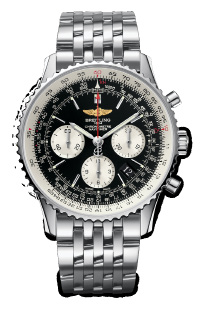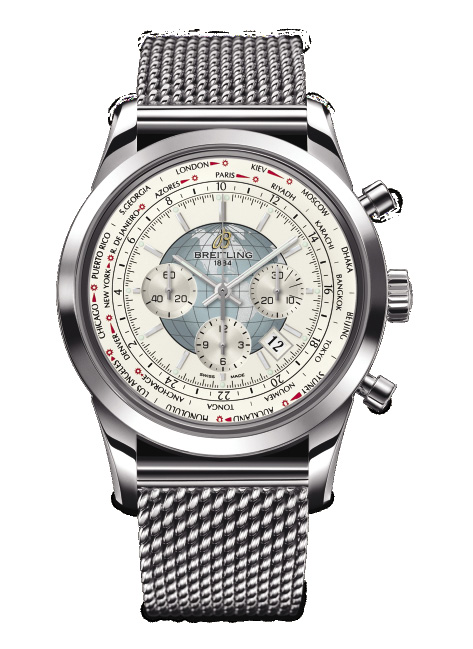


![]()
ONLINE

Mechanical Chronographs
Editors’ Note
Thierry Prissert assumed his current post in 2010. With a background in luxury, fashion, and high-end retailing, Prissert made his name with fashion brand Folli Follie from 1992 until 1999. His subsequent challenge, at luxury swimwear brand Vilebrequin, saw him move to the United States in 1999 before coming to Breitling.
Company Brief
A specialist of technical watches, Breitling (www.breitling.com) has played a crucial role in the development of the wrist chronograph and is a leader in this complication. The firm has shared all of the finest moments in the conquest of the skies thanks to its sturdy, reliable, and high-performance instruments. The world’s only major watch brand to equip all of its models with chronometer-certified movements, Breitling is also one of the rare companies to produce its own mechanical chronograph movement, entirely developed and manufactured in its own workshops. This family business is also one of the last remaining independent Swiss watch brands.
How has the Breitling brand evolved over time?
Since 1884, we have been owned by two families, so there has been continuity and adaptation for the long term. Since the early 20th century, we have been associated with commercial aviation. We started making watches in the ’30s and we made the first chronograph in 1952, which is still produced today.
Clients see that heritage today upon entering our stores. They can see it when they talk to pilots who wear the brand. So the heritage is important, but our watches are also active and modern, and are not only for pilots.
The affinity for aviation is also reflected in how we make the watch in terms of precision. All of our watches are certified; every one of them passes an exam before it goes on the client’s wrist – quality is a big focus.
Our owner is concerned with making a watch that is precise and robust, and that can stand the test of time and be serviced well.
Additionally, for the past three years, we have been able to make in-house movements ourselves. We just started making our own and we already have a world-time watch.

Breitling Navitimer 01
steel case with black
dial and steel bracelet
Have the collections generally remained the same or are you bringing new models in?
The range of watches evolves. The constant thing is we specialize in mechanical chronographs – we have a lot of models within that category.
Every year, we offer a model that is in a new range. We recently revived the Transocean – that was a watch of the ’70s.
So the collection has some additions in terms of product and lines, but it’s rare that we introduce a watch that isn’t a mechanical chronograph.
Why is your partnership with Bentley the right fit?
Bentley was also started by an individual owner, so the values of the companies are very similar. We build watches that are precision instruments for professionals and both of our companies’ products are all about performance. A Breitling watch also has a special look and personality. A Bentley is a mix of a sedan and a sports car, and Breitling also looks great and is easy and comfortable.
Our Breitling for Bentley collection is 10 years old and we began sponsoring the brand when they reintroduced the racing program in 2003. The owners of the brand then started discussing a collection of watches and put our watch in their car.
It’s the only partnership between a watch company and a car brand that has lasted 10 years.

Transocean Chronograph Unitime
steel bracelet
How broad is the range of clientele for your brand?
By definition, the Swiss watch industry is a niche market. The size of one’s niche is another topic. We make watches for people who can afford a $5,000 watch, which is our entry price point.
The beauty is that we can reach people who would save for a watch and be proud to be a Breitling owner and we also have the collectors who buy a watch every six months.
In terms of our production worldwide, it’s still a niche but one where we have a lot of players. We’re confident that with our approach to the manufacturing, marketing, sales, and after-sales service of our watches, we’re gaining clients and exposure every day.
How critical is it to train your team and push the understanding about the timepieces out to the market?
It’s key, because Breitling is an amazing product but a client needs to discover that. A watch is an instrument you need to be careful with and present in a certain way to explain to clients how it works and how it’s taken care of.
In our stores, we spend a lot of time training our people and we’re confident that they give the customer service that is necessary. However, it’s tougher at jewelers that are great partners but represent several brands.
We train on the history of the brand, on the product and on how to sell the line. We have a training team in place that can go to our partners and not just teach them how to sell Breitling, but also how to present Breitling so the consumer has the right perception of who we are.
How important is after-sales service?
It’s the number-one priority. A client is spending at least $5,000 on a watch so we need to make sure it’s serviced well.
Our owner announced last year that on every in-house movement we make, we will give the client a five-year warranty. There is not another Swiss watch brand in the world that does that, so it’s not just talk about great after-sales service.
Will you open more stand-alone boutiques in the U.S.?
Our first boutique was in New York, and now we have one in Shanghai, Beijing, and Paris, and we’re opening one in London.
There is nothing that tells the story better about a product or a brand than when you see the entire collection laid out in a boutique.
The goal, however, is not to roll out more boutiques just to sell watches because we have great partners in the U.S., and the majority of our business is done with jewelers that have helped support the brand for many years.
In late 2012, we opened a boutique in Las Vegas, a flagship for the West Coast; we recently opened one in Orlando, Florida. We don’t have plans for additional openings in 2013 but major cities like Chicago and Los Angeles could probably host a flagship in the future.•